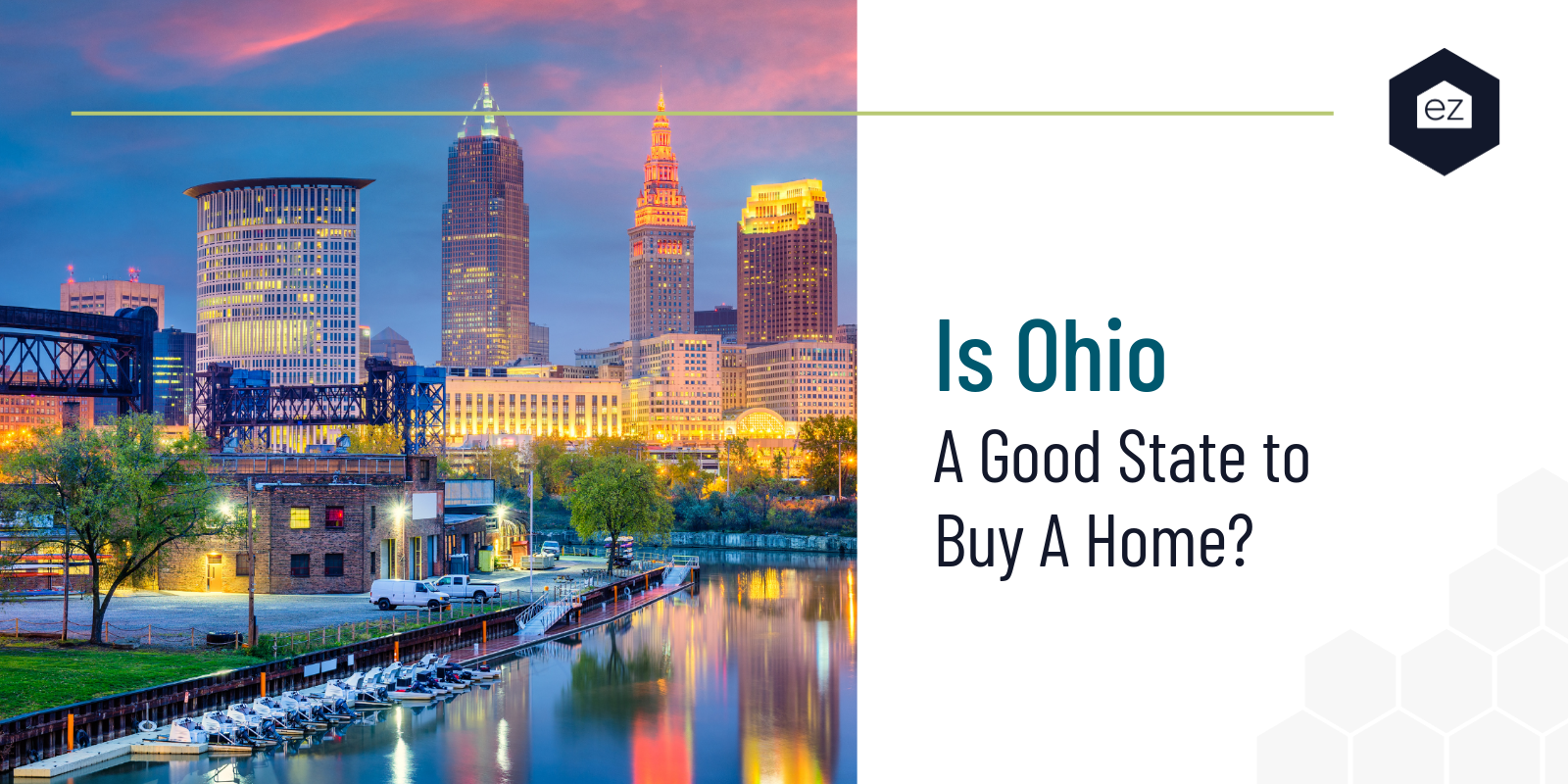Is Ohio A Good State to Buy A Home?

Is Ohio A Good State to Buy A Home?
Are you in the process of deciding where to buy a home and wondering if Ohio is the place for you? You may be surprised to learn that the Buckeye State has many attributes that make it a great state for buying a home.
In this article, we’ll examine various reasons why Ohio is an excellent state to consider purchasing a house. From top-notch schools and neighborhoods to a decent cost of living, we’ll break down everything you need to know about buying real estate in Ohio so that you can make the best decision possible when it comes time to purchase your dream home!
What is the cost of living in Ohio?

One of the perks of living in Ohio is its affordable cost of living. Overall, it’s about 17% cheaper to live here compared to the national average. Housing is one of the places where you will see the most savings. Statewide, the median housing price in Ohio was $179,700, making it 38% cheaper than the rest of the nation in 2022.
Not only is housing affordable, but you’ll see cost savings in almost every category. Utilities cost an average of $331.84 in 2021, while internet access was an average of $60.
Of course, this is just a look at the state on the whole. Pricing can vary, so you will have to look closer at the different cities you might be considering. For example, living in The Village of Indian Hill outside Cincinnati is an overall 110% more than the state average. For electricity costs in the Cleveland-Akron metro, you’ll pay an average electrical price per kWh of $11.91, below the national average of $13.71. The point is, your actual expenses will vary widely in all categories.
How much money do you need to live in Ohio?

Cost savings are obviously a big reason to choose Ohio for your home. In looking at MIT’s living wage calculation, a single adult would need to make $15.33 to have a living wage in the state. For a family of four with two children and one adult working, that would be $36.41.
And your typical expenses for a family of four would be $11,812 a year for food, $10,825 for housing, and $14,164 for transportation. The required annual income after taxes to cover all expenses would be $65,295, not including childcare costs.
In 2022, the average Ohio home value was $213,000. Housing costs could run anywhere from $642-$1,592 per month, spending on size, market, and renting versus buying.
Again, what you’ll actually spend depends on where you live. In 2023, some of the state’s most expensive places to live based on housing prices, property taxes, and other expenditures were Upper Arlington, Galena, and Dublin. All three of these were in the Columbus metro. However, other suburbs were listed as the most expensive exclusively on their home values, such as Beachwood, The Village of Indian Hills, and Willoughby Hills. These are closer to Cleveland or Cincinnati.
Is Ohio tax-friendly?
Taxes are going to be a mixed bag in Ohio. Overall, you won’t find it listed as one of the highest or the lowest states for its tax burden.
Ohio does charge a personal income tax, with state taxes ranging from 2.764-3.99% depending on how much you earn. However, cities and school districts can also charge income tax, adding 3% to your burden.

The sales taxes are relatively modest, with a 5.75% state charge. Local municipalities can add up to 2.25%. Statewide, the average sales tax rate was 7.24% in 2022. The good news is groceries and prescription drugs are exempt from sales taxes.
For retirees, Social Security, military, and railroad retirement benefits are not taxed. There are some tax breaks for retirement income, depending on your state tax base. These are leveraged in the form of tax credits and maxes out at $200 per return.
Property taxes are on the high end, as Ohio ranks 11th for its average effective tax rate, which looks at how much in taxes were paid against the property value. In 2022, this was 1.56% for an average of $3,390. Taxes are assessed at the county level, so millage rates vary widely. Looking at the median amount of taxes paid by homeowners, Delaware, Geauga, and Warren Counties were the most expensive, while Monroe, Noble, and Morgan Counties were the least expensive.
What is Ohio’s real estate market like?
Based on the data available for 2022, Ohio’s real estate market was following the same national trend of declining inventory and sales activity but rising median prices. In year-over-year price appreciation, the state rose 3.2% for an average sales price of $234,794. Compared to the national sales price of $400,000 at the same time, Ohio is a rather affordable state to buy a home.

In 2022, ten of the 15 markets tracked by the Ohio Association of Realtors ® experienced an increase or maintained their pricing status in January 2022. The Firelands and Scioto Valley areas had the most pricing growth, while Columbus had the highest average sales price. The busiest markets in early 2023, in terms of the number of sales, were Athens, Greater Portsmouth, and Knox County.
What are some key places to live in Ohio?
Cincinnati has long been one of the key places to live in Ohio. It’s conveniently located on the Ohio River near Kentucky and Indiana, making it an ideal jumping-off point for those who love to explore. The city has a sports district along the waterfront, a large arts and cultural scene, exciting nightlife, and great restaurants. Cincinnati’s beautiful park system boasts three major parks perfect for outdoor activities such as biking, running, and walking.
The capital of the Buckeye State, Columbus, is a great place to experience all that Ohio has to offer thanks to its central location. You can be anywhere in the state in about 2-3 hours. But you don’t need to travel far. Columbus provides many year-round attractions, from its unique arts district to its bustling downtown with museums and riverside parks. With excellent job prospects and access to top schools, Columbus ticks a lot of boxes.

Cleveland is a fantastic place to live in Ohio! Home to the Rock’n’Roll Hall of Fame, Cleveland Museum of Art, and the Cleveland Orchestra, Cleveland delivers rich cultural experiences. Plus, Cleveland is the center of world-class hospitals and several well-ranked universities.
Then there’s Dayton, a hub for innovation, especially in technology and aerospace. It’s ranked as one of the state’s best places to live because of its affordability and extensive park system. The nearby Wright-Patterson Air Force Base adds stability. Its National Museum of the U.S. Air Force is a bucket list attraction.
With access to Akron’s green spaces like Akron Metro Parks, Akron Zoo, and more than 25 miles of trails, finding ways to spend your time in this city won’t be a problem. If you are looking for an eclectic neighborhood filled with interesting culture or a downtown full of shopping and entertainment, Akron has exactly what you want at small-town pricing.
In Sandusky, enjoy small-town living at its best along Lake Erie, with plentiful outdoor activities like fishing, boating, biking, bird-watching, and more! Cedar Point amusement park and its thrilling roller coasters are in your backyard.
What are the pros of living in Ohio?
One of the biggest pros is affordability. Housing and groceries are not as expensive compared to other states, making it a much more cost-effective place to live. And, as part of America’s heartland, you’ll have fresh access to produce and groceries through the local farmer’s markets that operate in many of Ohio’s towns.

If you like to live in all four seasons, Ohio’s weather is another plus. Hot summers give way to idyllic winter days. The towns around Lake Erie experience lake-effect snow, perfect for days of cross-country skiing, sledding, or an old-fashioned snowball fight. In the summers, cool off in the lakes and reservoirs across the countryside.
Ohio’s economy has also been on an upswing in recent years, with growing job prospects and businesses proving it’s a great place to live and work. Find three innovation districts spread across the state, along with 27 Fortune 500 companies like CardinalHealth and Kroger. Columbus is a growing tech hub and ranks among the top ten rising startup cities. Cincinnati also made that list. Finally, with innovative medical centers and large hospitals, the state is a leader in pharmaceutical trials.
It’s also one of the top educational hubs in the U.S., with world-class institutions like The Ohio State University and Case Western Reserve making it an attractive choice for students. Its public school system ranked no. 20 in the nation, with two of its high schools cracking the national top ten list.
Sports are a year-round event when you live in Ohio. Pick from professional teams like Cleveland Indians, Cleveland Cavaliers, Cincinnati Bengals, and Columbus Blue Jackets. Columbus hosts the annual Arnold Sporting Competition each year, a fitness enthusiast’s must-attend event. And, on top of that, there’s the passionate fan base for The Ohio State Buckeyes.
What are the cons of living in Ohio?

While living in Ohio has many perks, it has its downsides. For example, you may not be thrilled with the climate if you’re not into four-season weather. Summers can get humid and hot with very little breeze or afternoon storms to offer relief. The bitter cold winters can leave no room for outdoor activities. The southern part sees much less snow than the north, meaning it’s cold without the perks of skiing or ice skating. At the same time, those lake-effect snows mean northern Ohioans must get used to digging out their cars and driveways after a good storm.
If public transportation is your go-to form of transportation, then living in Ohio might throw you a curveball since there is no widespread or reliable transit system. Inside the cities, the bus networks aren’t horrible, but it’s definitely easier to get around by car.
In addition, parts of the state are pretty, like the Marblehead peninsula along Lake Erie or the Hocking Hills region in southwestern Ohio. But in between, the glacial plain means much of the state is just flat farmland.
Major cities like Cleveland, Cincinnati, and Columbus are balanced by small towns that don’t quite have all the amenities of a modern metropolis. You can go places with little access to cell service, high-speed internet, or stores that stay open after 9pm.
While everyone wants to live in different places for different reasons, thinking about these potential drawbacks before settling down in Ohio is certainly something to take into account.
Living in Ohio
There’s no right or wrong answer about which state is good to buy a home. It’s about what you want from your life and if the place has the amenities you need.
Ohio’s no doubt an affordable state on the whole. It’s easy to live comfortably in this midwestern state with reasonable housing, grocery, and utility prices. Residents can access outdoor activities thanks to the city Metro Park systems or nearby state preserves. And the state’s major cities have enough arts and cultural attractions to stay entertained all year round.
If Ohio sounds interesting to you, why not learn more about the state and some of its best places to live? Check out our moving guide or learn about Ohio from a local real estate agent.
Start Your Home Search
Preston Guyton
Share this Post
Related Articles
Buying a Home
What to Know About Termites In Your Home
Buying a Home
What to Know About Spray Foam Insulation
Buying a Home
5 Most Affordable Places to Buy a Home in Tennessee
Buying a Home





